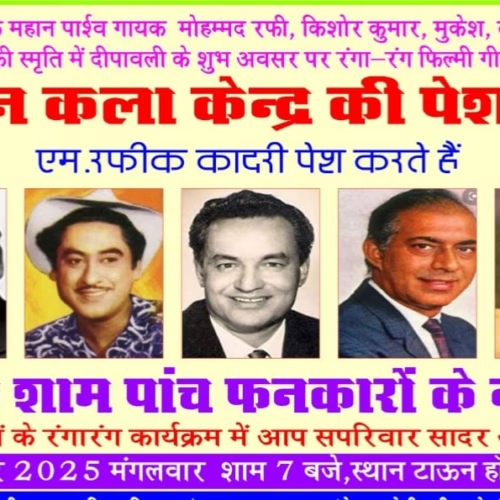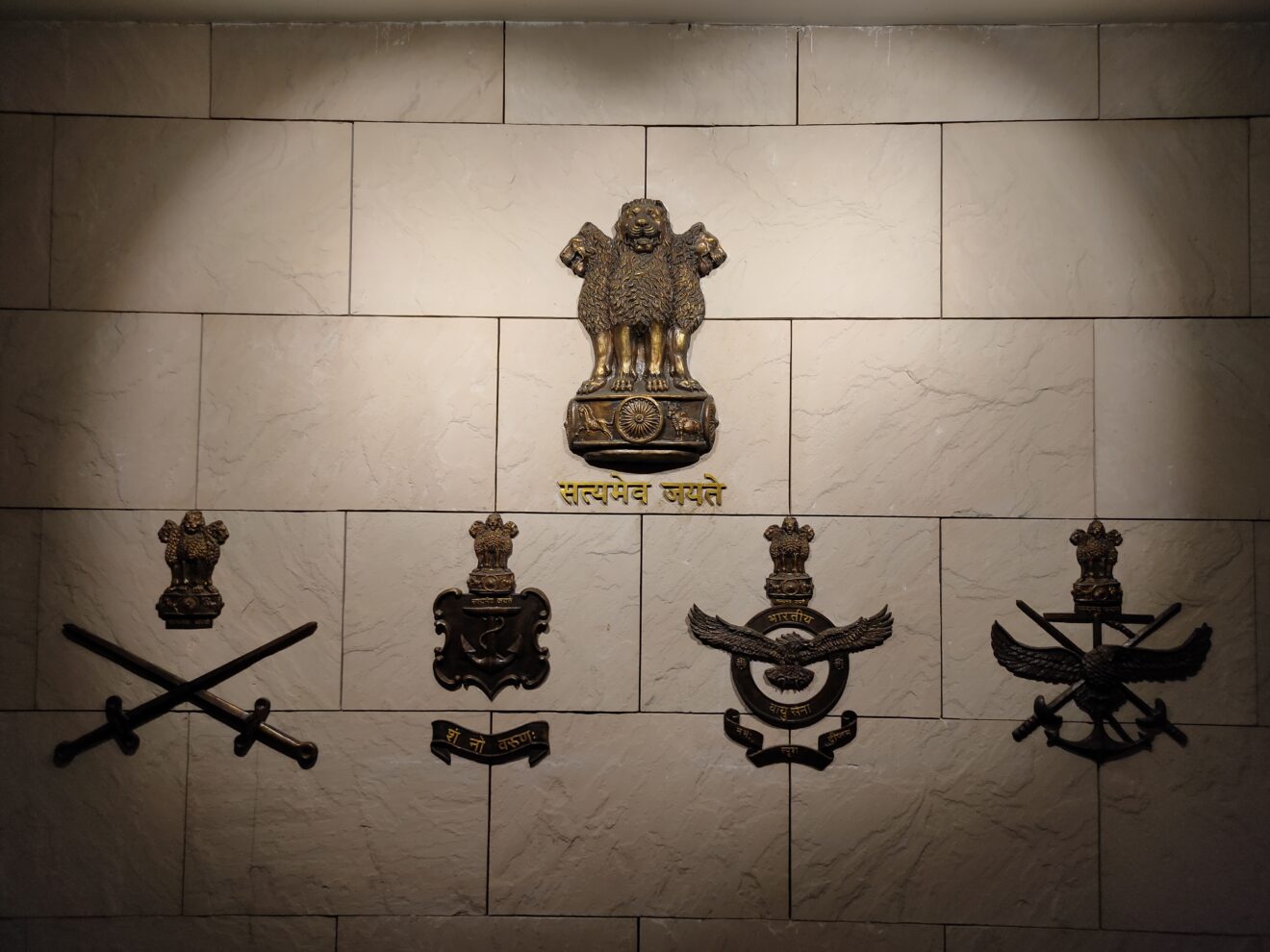BY DEFENCE JOURNALIST SAHIL | T.I.N. NETWORK
Exercise Trishul 2025: India Showcases Unmatched Tri-Service Synergy, Amphibious Power Projection and Future-Ready Combat Integration
Madhavpur Beach in Porbandar, Gujarat, transformed into a high-intensity operational theatre as India’s premier land, sea and air formations converged for the culminating phase of Tri-Services Exercise 2025 “Trishul”—a sweeping, multi-domain demonstration of India’s integrated combat power. Led by the Indian Navy as the principal coordinating service, the exercise stitched together strategic objectives of the Indian Army, Indian Navy and the Indian Air Force, reinforcing India’s growing focus on jointness, interoperability, and multi-theatre readiness.
The highlight of the concluding phase was the presence of Lt Gen Dhiraj Seth, General Officer Commanding-in-Chief, Southern Command, who reviewed and assessed the amphibious operations, integrated landings, and tri-service manoeuvres. The Army Commander’s participation, alongside senior naval and air leaders, signalled the seriousness with which India is accelerating its joint warfighting doctrines.
Lt Gen Dhiraj Seth Reviews Amphibious Operations at Madhavpur Beach
The final phase unfolded dramatically at Madhavpur Beach, where Lt Gen Dhiraj Seth witnessed full-spectrum amphibious landing operations conducted from the Indian Navy’s expeditionary platform, INS Jalashwa. The massive LPD (Landing Platform Dock) served as the command and control centre for the assault waves, deploying men, machinery, and armour in precision-timed sequences onto the beachhead.
Lt Gen Seth embarked onboard INS Jalashwa along with:
- Vice Admiral Krishna Swaminathan, Flag Officer Commanding-in-Chief, Western Naval Command
- Air Marshal Nagesh Kapoor, Air Officer Commanding-in-Chief, South Western Air Command
The tri-service leadership evaluated the operational readiness and coordination mechanisms essential for executing large-scale amphibious missions. The Army Commander oversaw the launch of the first Infantry Platoon with a Tank, transported by Landing Craft Mechanised (LCM) during the initial assault wave—a meticulously planned demonstration of beaching operations under combat-simulated conditions.
These landings showcased precision timing, unified command structures, real-time data sharing, and fluid cross-domain decision-making—the backbone of future joint operations.
A Seamless Tri-Service Display of Combat Integration
Exercise Trishul 2025 was not a standalone tactical drill—it was a theatre-wide operational simulation stretching from the Western Seaboard to the Desert Sector, and deep into the Creek and Rann sectors of Rajasthan and Gujarat. Together, these terrains enabled a realistic testing ground for integrated operations across land, sea, air, cyber, and electronic domains.
Key Elements Demonstrated:
1. Amphibious Landings & Littoral Warfare
INS Jalashwa, along with associated amphibious forces, executed coordinated landings involving infantry, mechanised elements, combat support teams, and logistics modules—validating India’s ability to project military power from sea to land in contested zones.
2. Integrated Air-Land-Sea Operations
The Indian Air Force deployed fighter aircraft, transport platforms, and ISR assets that synchronised with naval aviation and Army ground forces. Air cover, tactical lifts, airborne ISR, EW support, and maritime-surveillance inputs were integrated into the ground manoeuvre plans.
3. Carrier Operations in Joint Environment
The Indian Navy conducted carrier-borne air operations in coordination with shore-based IAF fighters, enabling a rare cross-service harmonisation of air doctrine, SOP validation, and communication protocols.
4. Joint ISR, EW and Cyber Warfare Plans
Multi-layered Intelligence, Surveillance and Reconnaissance (ISR) systems were synchronised with electronic warfare and cyber capabilities—simulating modern contested battlespaces and countering emerging threats.
5. Multi-Theatre Operations Across Harsh Terrains
From creek sectors to desert warfare zones, formations practiced manoeuvres designed to validate India’s expanded multi-domain operational reach and adaptability.
Indigenous Technology at the Forefront: Aatmanirbhar Bharat in Action
One of the strongest messages emerging from Trishul 2025 has been the centrality of indigenous systems. The exercise emphasised Indian-made platforms, weapon systems, surveillance tools, command-and-control networks, artillery systems, specialised vehicles, and EW suites.
The Indian Army’s deployment of indigenous weapons and new-generation combat technologies underscored the advancements India has made under the Aatmanirbhar Bharat framework—ensuring strategic autonomy, operational sustainability, and rapid modernisation.
The drills reflected:
- Absorption of new battlefield technologies
- Integration of modern sensor grids and networked communication
- Use of AI-enabled tools for decision support
- Employment of domestically-built amphibious and mechanised systems
India’s growing self-reliance was visible not only in platforms but also in the procedures, software-based solutions, and mission planning tools tailored to Indian threat landscapes.
Inter-Agency Participation Enriches Joint Capability
To reinforce whole-of-nation coordination, the Indian Coast Guard, Border Security Force, and several central agencies joined the exercise. Their participation aligned operational capabilities beyond the armed forces and enabled a more layered response architecture—vital for handling multi-spectrum security situations in future scenarios.
This inter-agency synergy underlined the fact that modern conflicts demand integrated responses involving maritime law enforcement, border security frameworks, intelligence agencies, and logistic support organisations.
Leadership Recognition and the Push for Jointmanship
After reviewing the operations, Lt Gen Dhiraj Seth commended the professionalism, jointmanship, operational finesse, and tri-service interoperability displayed by soldiers, sailors, and air warriors. His acknowledgment highlighted the Armed Forces’ unwavering commitment to preparedness in dynamic and contested environments.
Senior leadership across all three services emphasised that exercises like Trishul are pivotal in refining joint doctrines, strengthening multi-service C4ISR networks, and enhancing rapid mobilisation and joint manoeuvre capabilities.
Reinforcing India’s National Security Architecture
Exercise Trishul 2025 stands as a cornerstone of India’s evolving military strategy—one that recognises the centrality of multi-domain warfare, theatre integration, and indigenous innovation. Its successful execution reaffirms India’s readiness to:
- Conduct high-end joint operations
- Execute amphibious and littoral campaigns
- Counter multi-domain threats
- Protect strategic coastlines and border areas
- Sustain large-scale combat operations in challenging terrains
By delivering a coherent and integrated display of land, maritime and air power, the tri-services exercise has sent a clear message: India is rapidly transitioning towards a joint, network-enabled, future-ready combat force powered by Aatmanirbhar Bharat and sharpened through realistic operational training.
Conclusion
The 2025 edition of Exercise Trishul was more than an annual drill—it was a blueprint of India’s defence posture of the future. With seamless coordination across services, decisive leadership oversight, extensive use of indigenous technology, and a powerful display of amphibious and multi-domain capabilities, the exercise has cemented India’s position as a confident, capable, and integrated military power prepared for the evolving dynamics of modern warfare.
It stands as a testament to the Indian Armed Forces’ collective resolve to defend national interests with precision, strength, and unity—anywhere, anytime, across domains and frontiers.
BY DEFENCE JOURNALIST SAHIL | T.I.N. NETWORK
त्रिशूल एक्सरसाइज़ 2025: भारत की त्रि-सेवा संयुक्त शक्ति, उभयचर सामरिक प्रभुत्व और भविष्य-उन्मुख युद्ध क्षमता का भव्य प्रदर्शन
गुजरात के पोरबंदर स्थित माधवपुर बीच पर भारत की थल, जल और वायु सेनाओं ने वह नज़ारा पेश किया, जिसने आधुनिक युद्धकला में भारत की उभरती सामरिक शक्ति और त्रि-सेवा एकीकरण को नई परिभाषा दी। त्रि-सेवा सैन्य अभ्यास 2025 “त्रिशूल” का यह अंतिम चरण न केवल भारत की संयुक्त युद्धक क्षमताओं का प्रतीक बना, बल्कि इसने तीनों सेनाओं—भारतीय सेना, भारतीय नौसेना और भारतीय वायुसेना—के बीच अभूतपूर्व तालमेल और भविष्य के बहु-डोमेन युद्ध के लिए तैयारियों को सशक्त रूप से स्थापित किया।
इस समापन चरण का नेतृत्व भारतीय नौसेना ने किया, जबकि सर्वोच्च राजनीतिक-सामरिक महत्व इस बात से झलकता रहा कि दक्षिणी कमान के जनरल ऑफिसर कमांडिंग-इन-चीफ लेफ्टिनेंट जनरल धीरज सेठ स्वयं इस महाअभ्यास के उभयचर अभियान का प्रत्यक्ष निरीक्षण कर रहे थे। उनके साथ नौसेना और वायुसेना के शीर्ष कमांडर मौजूद थे, जो नई युद्ध अवधारणाओं को वास्तविक वातावरण में परखने का प्रमाण था।
माधवपुर बीच पर उभयचर लैंडिंग ऑपरेशन का उच्चस्तरीय निरीक्षण
अंतिम चरण का सबसे महत्वपूर्ण पहलू था भारतीय नौसेना के विशाल उभयचर युद्धक प्लेटफॉर्म INS जलाश्व से संचालित पूर्ण-विस्तृत उभयचर लैंडिंग ऑपरेशन।
INS जलाश्व ने कमांड-एंड-कंट्रोल हब के रूप में भूमिका निभाई, जिससे पैदल सैनिकों, बख्तरबंद वाहनों, लॉजिस्टिक मॉड्यूल और युद्ध सामग्री को सटीक समय पर तट पर उतारा गया।
लेफ्टिनेंट जनरल धीरज सेठ ने INS जलाश्व पर सवार होकर इस ऑपरेशन का निरीक्षण किया। उनके साथ उपस्थित रहे—
- वाइस एडमिरल कृष्ण स्वामीनाथन, फ्लैग ऑफिसर कमांडिंग-इन-चीफ, वेस्टर्न नेवल कमांड
- एयर मार्शल नागेश कपूर, एयर ऑफिसर कमांडिंग-इन-चीफ, साउथ वेस्टर्न एयर कमांड
तीनों सेनाओं के इन शीर्ष कमांडरों ने उभयचर युद्ध की जटिलताओं, इंटर-डोमेन कोऑर्डिनेशन, और रियल-टाइम निर्णय व्यवस्था का गहन अध्ययन किया।
सबसे महत्वपूर्ण क्षण तब आया जब लेफ्टिनेंट जनरल सेठ ने पहली इन्फैंट्री प्लाटून और एक टैंक को LCM (लैंडिंग क्राफ्ट मैकेनाइज़्ड) के माध्यम से बीचिंग ऑपरेशन के प्रथम वेव में तैनात होते देखा।
यह प्रक्रिया भारत की उभयचर क्षमता, संयुक्त कमांड स्ट्रक्चर और नेटवर्क-सक्षम युद्ध तैयारी का गहरा प्रमाण थी।
त्रि-सेवा युद्धक एकीकरण का व्यापक और वास्तविक परीक्षण
एक्सरसाइज़ त्रिशूल 2025 महज़ एक सामरिक अभ्यास नहीं था। यह एक सम्पूर्ण थिएटर स्तर का, बहु-डोमेन ऑपरेशन था, जो फैला था—
- पश्चिमी समुद्री तट
- राजस्थान का मरु-क्षेत्र
- कच्छ की खाड़ी और क्रीक सेक्टर
- गुजरात का तटीय क्षेत्र
इन सभी इलाकों में संयुक्त संचालन ने भविष्य के व्यापक युद्धक्षेत्र का यथार्थ मॉडल पेश किया।
मुख्य क्षमताएँ जो इस अभ्यास में प्रदर्शित हुईं
1. उभयचर लैंडिंग एवं लिटोरल वॉरफेयर क्षमता
INS जलाश्व और सहायक उभयचर बेड़े ने पैदल सैन्य टुकड़ियों, बख्तरबंद गाड़ियों, सपोर्ट यूनिट्स और लॉजिस्टिक ढांचों का सफल बीच लैंडिंग अभियान संचालित किया।
2. त्रि-डोमेन (थल-जल-वायु) संयुक्त ऑपरेशन
भारतीय वायुसेना ने फाइटर जेट, ट्रांसपोर्ट एयरक्राफ्ट, ISR प्लेटफॉर्म और EW सपोर्ट प्रदान किया।
नौसेना के समुद्री और हवाई संसाधनों ने सेना की ग्राउंड मैनवर यूनिट्स के साथ अभूतपूर्व तालमेल स्थापित किया।
3. कैरियर-आधारित संयुक्त एयर ऑपरेशन
भारतीय नौसेना के एयरक्राफ्ट कैरियर से उड़ान भरने वाले विमान और भारतीय वायुसेना के शोर बेस्ड फाइटर्स ने संयुक्त SOP और एयर डोमेन की एकीकृत युद्धक अवधारणाओं को प्रमाणित किया।
4. संयुक्त ISR, इलेक्ट्रॉनिक वॉरफेयर और साइबर योजनाएँ
इस अभ्यास ने बहु-स्तरीय सेंसर ग्रिड, नेटवर्क इंटीग्रेशन, इलेक्ट्रॉनिक डॉमिनेंस और साइबर क्षमता का एकीकृत मॉडल प्रस्तुत किया।
5. बहु-थिएटर युद्धक तैयारियाँ
मरुस्थल की चुनौतीपूर्ण जलवायु से लेकर क्रीक सेक्टर के जटिल भूगोल तक, सभी क्षेत्रों में युद्धक तालमेल और फायर-एंड-मैनवर क्षमताओं का परीक्षण किया गया।
‘आत्मनिर्भर भारत’ की सैन्य शक्ति का वास्तविक प्रदर्शन
त्रिशूल 2025 का सबसे महत्वपूर्ण आयाम था भारतीय स्वदेशी रक्षा प्रणालियों का व्यापक उपयोग। तीनों सेनाओं ने भारतीय तकनीक आधारित—
- हथियार प्रणाली
- निगरानी सेंसर
- कमांड-एंड-कंट्रोल नेटवर्क
- आर्टिलरी प्लेटफॉर्म
- विशेष सैन्य वाहन
- इलेक्ट्रॉनिक वॉरफेयर सूट
- AI आधारित निर्णय प्रणाली
का बड़े पैमाने पर प्रभावी उपयोग किया।
यह न केवल भारत की स्वदेशी सैन्य क्षमता का प्रमाण है, बल्कि युद्धक स्वतंत्रता और सतत् मॉडर्नाइजेशन की दिशा में निर्णायक कदम है।
इंटर-एजेंसी पार्टिसिपेशन: ‘Whole-of-Nation’ सुरक्षा मॉडल
इस अभ्यास में भारतीय तटरक्षक बल, BSF और विविध केंद्रीय एजेंसियों ने भी हिस्सा लिया।
यह व्यापक भागीदारी इस बात का संकेत है कि आधुनिक सुरक्षा व्यवस्था केवल सैन्य नहीं, बल्कि राष्ट्रीय-सुरक्षा तंत्र के हर अंग के संयुक्त प्रयास से संभव होती है।
कश्मीर से लेकर समुद्री सुरक्षा तक—हर मोर्चे पर इस तरह की संपूर्ण राष्ट्रीय भागीदारी आधुनिक युद्ध की पहली जरूरत बन चुकी है।
नेतृत्व की सराहना और संयुक्तता के प्रति प्रतिबद्धता
उभयचर अभियानों और संयुक्त संचालन का निरीक्षण करने के बाद लेफ्टिनेंट जनरल धीरज सेठ ने तीनों सेनाओं के सैनिकों, नाविकों और एयर वारियर्स की सराहना की।
उन्होंने कहा कि यह अभ्यास भारत की युद्धक तैयारी, प्रोफेशनलिज़्म और संयुक्तता का प्रतिबिंब है।
भारत की राष्ट्रीय सुरक्षा संरचना का सुदृढ़ भविष्य
एक्सरसाइज़ त्रिशूल 2025 ने स्पष्ट रूप से साबित किया कि भारत अब एक थिएटर-इंटीग्रेटेड, मल्टी-डोमेन, टेक्नोलॉजी-सेंट्रिक युद्ध प्रणाली की ओर तेज़ी से आगे बढ़ रहा है।
यह अभ्यास पुनः पुष्टि करता है कि भारत तैयार है—
- उच्चस्तरीय संयुक्त युद्ध संचालन के लिए
- समुद्र से भूमि पर शक्ति प्रक्षेपण के लिए
- बहु-डोमेन खतरों का जवाब देने के लिए
- सीमा सुरक्षा और समुद्री प्रभुत्व के लिए
- कठोर भूगोल में बड़े पैमाने पर ऑपरेशन चलाने के लिए
भारत ने एक स्पष्ट संदेश दिया—हम भविष्य के किसी भी संघर्ष के लिए तैयार हैं, और ‘आत्मनिर्भर भारत’ की शक्ति के साथ तैयार हैं।
एक्सरसाइज़ त्रिशूल 2025 केवल एक सैन्य अभ्यास नहीं था—यह भारत की विकसित होती रक्षा नीति, त्रि-सेवा एकीकरण और स्वदेशी तकनीकी शक्ति का विस्तृत प्रदर्शन था।
इसने दिखाया कि आधुनिक युद्ध में भारत एक मजबूत, तैयार और तकनीकी रूप से सक्षम शक्ति है।
भारत की तीनों सेनाओं ने एक बार फिर साबित कर दिया—
“हम एकजुट हैं, सक्षम हैं, और जब भी देश पुकारेगा—हर डोमेन में, हर सीमा पर, हर परिस्थिति में रक्षा के लिए तैयार हैं।”



















Add Comment